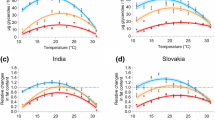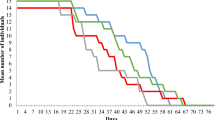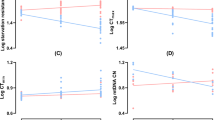Abstract
THE fact that in poikilotherms an increase in temperature reduces the life-span has naturally been taken as showing that the rates of ageing processes, like those of chemical reactions, are dependent on temperature. If so, an animal which is kept for an appreciable part of its life-span at a high temperature and is then transferred to a low temperature would be expected to die at a chronologically younger age than a similar animal kept continuously at the lower temperature. It has already been reported1,2 that this expectation is not realized in the case of D. subobscura. Flies kept when young at 30° C. for periods equal to about half their expectation of life at that temperature and then transferred to 20° C. died at the same chronological age as did flies kept continuously at 20° C.
This is a preview of subscription content, access via your institution
Access options
Subscribe to this journal
Receive 51 print issues and online access
$199.00 per year
only $3.90 per issue
Buy this article
- Purchase on Springer Link
- Instant access to full article PDF
Prices may be subject to local taxes which are calculated during checkout
Similar content being viewed by others
References
Maynard Smith, J., Nature, 181, 496 (1958).
Maynard Smith, J., J. Exp. Biol., 35, 832 (1958).
Neary, G. J., Nature, 187, 10 (1960).
Author information
Authors and Affiliations
Rights and permissions
About this article
Cite this article
CLARKE, J., SMITH, J. Independence of Temperature of the Rate of Ageing in Drosophila subobscura . Nature 190, 1027–1028 (1961). https://doi.org/10.1038/1901027a0
Issue Date:
DOI: https://doi.org/10.1038/1901027a0
This article is cited by
-
Diet and life extension in animal model systems
AGE (1978)
-
Environmental Temperature and Life Span in Poikilotherms
Nature (1968)
-
Temperature and the Rate of Ageing in Poikilotherms
Nature (1963)
Comments
By submitting a comment you agree to abide by our Terms and Community Guidelines. If you find something abusive or that does not comply with our terms or guidelines please flag it as inappropriate.



